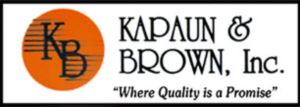
Ceiling fans are one of the most underrated ways to make your home more comfortable and lower energy costs. By enhancing air circulation and supporting your HVAC system, ceiling fans and energy efficiency are truly a natural pairing. They offer a smart, cost-saving way to keep cool while reducing strain on your AC—even preventing unnecessary air conditioning repair.
In this blog, the experts at Kapaun & Brown break down how ceiling fans can make your home feel more comfortable while saving you money thanks to increased HVAC efficiency. We'll also provide some HVAC efficiency tips that put to good use ceiling fans.
Comfort vs. Temperature: Getting Comfortable with the Wind-Chill Effect Indoors
Ceiling fans don’t actually lower the room temperature—they make your home more comfortable by moving air over your skin. This is called the wind-chill effect, and it can make a room feel up to 4 degrees cooler without touching the thermostat. That means you remain cool and enjoy the benefits of indoor air circulation from your ceiling fan while using less AC—helping reduce your electric bill in summer.
The Best of Both: Why You Should Use Fans and Air Conditioning Together
There are several benefits to using ceiling fans and air conditioning in tandem, especially during the warmer months. By combining both, you increase HVAC efficiency and enjoy a cooler living space with less strain from your cooling system.
Why you should use ceiling fans and AC together:
- Ceiling fans help lower HVAC load by spreading cool air more evenly around a room. Decreasing HVAC stress is important, because it can prevent a breakdown that may lead to premature AC or furnace installation.
- Using overhead fans boosts the comfort level of your home by reducing uneven temperatures and increasing airflow.
- Combining ceiling fans and AC can lower your utility usage. If you have a home automation system, you can even modify your smart thermostat settings to bump up the temp a few degrees while your ceiling fan is running.
Clockwise vs. Counterclockwise Ceiling Fan Rotation: What Direction to Spin in Summer and Winter?
To maximize the benefits of your ceiling fans year-round, it’s important to make sure the blades rotate in the proper direction for the season. The direction influences how air circulates, which can either cool you down or redistribute heat so you feel warmer.
When to rotate ceiling fans counterclockwise
In the summer, ceiling fans should spin counterclockwise at a faster setting. This creates a breeze that moves air toward the floor, increasing the wind-chill effect and creating a cooler sensation.
When it's best to spin ceiling fans clockwise
On cold days, set your fan to rotate clockwise on a slower speed. This gently pulls cool air upward and draws warm air downward from the ceiling, so you feel warmer without adjusting your thermostat.
What Type of Ceiling Fan Is Best
Picking the right ceiling fan depends on a few key factors, including blade design, airflow rating and room dimensions. First, look for fans with a good combination of ECFM airflow and blade pitch to deliver efficient air movement in your space:
- ECFM refers to the amount of air a fan pushes—the cubic feet per minute, or CFM—per watt of electricity it uses. Fans with greater ECFM are the most energy efficient.
- Blade pitch refers to the incline of the blades. A steeper blade pitch moves more air than a shallower pitch but can also strain the motor.
Also, consider room size when sizing a ceiling fan—a fan that’s too small won’t move enough air, while one that’s too big may be disruptive in a smaller room.
Increase Your HVAC Efficiency With the Team from Kapaun & Brown
At Kapaun & Brown, our HVAC experts can help you enjoy year-round comfort while easing the burden on your heating and cooling systems. From efficient ceiling fan strategies and air conditioning installation to smart thermostats and furnace repair, we offer comprehensive services that work with your budget. Reserve your appointment by calling 641-321-6747 today.
